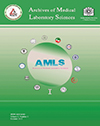Dermatomycoses among Students in a School Dormitory in Semnan
Archives of Medical Laboratory Sciences,
Vol. 1 No. 2 (2015),
12 October 2015
https://doi.org/10.22037/amls.v1i2.10297
Abstract
Background: Dermatomycoses are a major public health problem. Tinea cruris is a form of Dermatomycoses.Tinea cruris is a common infection in the groin area, genitals, pubic area, perineum and perianal skin.The purpose of thisstudywas to investigate the cutaneous fungal infections among students in a school dormitory.
Materials and Methods: The study was performed on 110 male students dormitory aged between 18 to 28 years.From the specimens obtained, direct preparations were made using %10 potassium hydroxide and cultured on sabouraud dextrose agar containing 0.05 mg/ml chloramphenicoland 0.5 mg/ml cycloheximide (Scc). Identification of fungi was performed according to morphologic and microscopic growth of the colonies and using slide culture method.
Results: 17 people out of 110 individuals were diagnosed with cutaneous fungal infections. Six people were diagnosed with dermatophytosis. All cases of dermatophytosis were Tinea cruris. Epidermophyton floccosum, the anthropophilic species, was only isolated dermatophyte.The prevalence of Tinea cruris was 5.5% and the Prevalence of Pityriasis versicolor was 4.5%.
Conclusion: The most important source of transmission of anthropophilic dermatophyte species was by men to men.The results of this study is similar to most other studies in Iran and other countries. In addition to treatment, other necessary steps should be applied in order to prevent infection and reduce the risk of pathogens.
- Dermatomycoses
- Dermatophytosis
- Epidermophyton
- Tinea cruris
How to Cite
References
Ameen M. Epidemiology of superficial fungal infections. Clinics in dermatology. 2010;28(2):197-201.
Seebacher C, Bouchara J-P, Mignon B. Updates on the epidemiology of dermatophyte infections. Mycopathologia. 2008;166(5-6):335-52.
Ogba O, Abia-Bassey L. Tinea Cruris Resurgence in Male Genitalia: A Case Report. International Journal of Basic, Applied and Innovative Research. 2014;2(3):51-4.
Arıdoğan I, Ateş A, Izol V, Ilkit M. Tinea cruris in routine urology practice. Urologia internationalis. 2005;74(4):346-8.
Surendran K, Bhat RM, Boloor R, Nandakishore B, Sukumar D. A clinical and mycological study of dermatophytic infections. Indian journal of dermatology. 2014;59(3):262.
Rassai S, Feily A, Derakhshanmehr F, Sina N. Some epidemiological aspects of dermatophyte infections in Southwest Iran. Acta Dermatovenerologica Croatica. 2011;19(1):0-.
Chepchirchir A, Bii C, Ndinya-Achola J. Dermatophyte infections in primary school children in Kibera slums of Nairobi. East African medical journal. 2009;86(2).
Khosravi A, Aghamirian M, Mahmoudi M. Dermatophytoses in Iran. Mycoses. 1994;37(1‐2):43-8.
Nweze E, Okafor J. Prevalence of dermatophytic fungal infections in children: a recent study in Anambra State, Nigeria. Mycopathologia. 2005;160(3):239-43.
Rahman MH, Hadiuzzaman MM, Jaman MMK, Bhuiyan M. Prevalence of superficial fungal infections in the rural areas of Bangladesh. Iranian Journal of Dermatology. 2011;14(3):86-91.
Vena GA, Chieco P, Posa F, Garofalo A, Bosco A, Cassano N. Epidemiology of dermatophytoses: retrospective analysis from 2005 to 2010 and comparison with previous data from 1975. Microbiologica-Quarterly Journal of Microbiological Sciences. 2012;35(2):207.
Danesh‐Pazhooh M. The frequency of tinea pedis in patients with tinea cruris in Tehran, Iran. Mycoses. 2000;43(1‐2):41-4.
Bhatia VK, Sharma PC. Epidemiological studies on Dermatophytosis in human patients in Himachal Pradesh, India. SpringerPlus. 2014;3(1):134.
Naseri A, Fata A, Najafzadeh MJ, Shokri H. Surveillance of dermatophytosis in northeast of Iran (Mashhad) and review of published studies. Mycopathologia. 2013;176(3-4):247-53.
Maraki S. Epidemiology of dermatophytoses in Crete, Greece between 2004 and 2010. Giornale italiano di dermatologia e venereologia: organo ufficiale, Societa italiana di dermatologia esifilografia. 2012;147(3):315-9.
García-Martos P, García-Agudo L, Agudo-Pérez E, de Sola FG, Linares M. Dermatophytoses due to anthropophilic fungi in Cadiz, Spain, between 1997 and 2008. Actas Dermo-Sifiliográficas (English Edition). 2010;101(3):242-7.
Ahmadinejad Z, Razaghi A, Noori A, Hashemi S-J, Asghari R, Ziaee V. Prevalence of fungal skin infections in Iranian wrestlers. Asian journal of sports medicine. 2013;4(1):29.
Falahati M, Akhlaghi L, Lari AR, Alaghehbandan R. Epidemiology of dermatophytoses in an area south of Tehran, Iran. Mycopathologia. 2003;156(4):279-87.
Sepahvand A, Abdi J, Shirkhani Y, Fallahi S, Tarrahi M, Soleimannejad S. Dermatophytosis in western part of Iran, Khorramabad. Asian Journal of Biological Sciences. 2009;2(3):58-65.
Pakshir K, Hashemi J. Dermatophytosis in Karaj, Iran. Indian journal of dermatology. 2006;51(4):262.
Bassiri-Jahromi S, Khaksari AA. Epidemiological survey of dermatophytosis in Tehran, Iran, from 2000 to 2005. Indian Journal of Dermatology, Venereology, and Leprology. 2009;75(2):142.
Aghamirian MR, Ghiasian SA. Dermatophytoses in outpatients attending the dermatology center of Avicenna Hospital in Qazvin, Iran. Mycoses. 2008;51(2):155-60.
Jankowska‐Konsur A, Dyląg M, Hryncewicz‐Gwóźdź A, Plomer‐Niezgoda E, Szepietowski JC. A 5‐year survey of dermatomycoses in southwest Poland, years 2003–2007. Mycoses. 2011;54(2):162-7.
Stenwig H, Taksdal T. Isolation of Epidermophyton floccosum from a dog in Norway. Sabouraudia: Journal of Medical and Veterinary Mycology. 1984;22(2):171-2.
- Abstract Viewed: 310 times
- PDF Downloaded: 190 times
